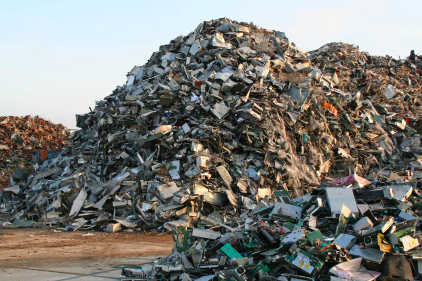Think e-waste is a foreign problem? Guess again.
More for Less
The number of electronic goods and electronic users continues to climb every year. The new U.S. Consumer Electronics Association (CEA) reports that total industry revenue of consumer electronics market will reach another all-time high of $214 billion in 201, as opposed to $211.3 billion of sales in 2014. According to the CEA’s forecast, the revenues from emerging product categories have grown by 10% year-over-year in 2015.With falling prices, sales of consumer electronic products are skyrocketing, but the quality of products is also falling, as the manufacturing of all the giant companies like Apple, Dell, HP, LG, and Samsung has moved to China and to other Asian countries. Cheap labor and the cheap electronic components available in Asian countries has made the dream of affordable electronic products come true. Some manufacturers even produce “derivative models,” which are the scaled-down version of their normal products, to make cheap products even cheaper.
These derivative models use lower quality parts and components, which significantly reduces their life span. It is true that cellphones, laptops, CRTs, flat screen TVs, tablets, printersand LCD Displays have made our lives easier and more productive, but electronic waste is fast becoming an overwhelming problem. In fact, because of the toxicity of the pollutants produced while e-waste is burned or recycled in an uncontrolled environment, the Basel Convention has identified e-waste as especially hazardous.

The Biggest Culprit
What's the most common e-waste component? Cellphones. In 2014, new smartphone releases and an increased emphasis on emerging markets drove global smartphone shipments above 300 million units for the second consecutive quarter. In the US, the preoccupation with having the newest devices means that the average American upgrades his cell phone every 21.7 months. In 2005, 100 million cell phones were discarded in the United States, and in 2010 the number reached 150 million.Those abandoned cellphones end up in places like Agbogbloshie, Ghana, Delhi, India, and Guiyu, China, where people burn piles of cell phones to extract useful metals like gold, silver, and copper in the open air. Even a small amount of exposure to this kind of e-waste causes serious health risks, especially to pregnant women and children: even a very low level of exposure to e-waste can cause irreversible neurological damage and threaten the development of a child.

Slow Solutions
While customers could play their part in reducing electronic waste, the desire for ever-newer electronics is not likely to ebb soon. One solution is encouraging manufacturers to play a better role in recycling e-waste in a controlled environment. It is true that electronic companies have to keep innovating and advancing their products in order to stay ahead of the competition, but if these companies could come up with a pact that would allow the companies to release their new product every two years or something to that effect, there would be a significant decrease in the accumulation of e-waste on the planet. Also, manufacturers could recycle the metals from the old cell phones, which would prevent both excessive mining and reduce future e-waste.Some companies have made small advancements. For instance, Samsung claims to have recycled 464,631,328 lbs of electronic products through its private recycling program. Apple has a policy of giving gift cards to customers who recycle their electronic products through their Apple Recycling Program. Retailers are starting to do their part as well: giants like Best Buy, Amazon, Walmart, and Target have already started providing incentives and free recycling services to customers who recycle their old and used phone. BestBuy claims to have recycled one billion lbs of electronic goods so far.
But even with retailers and manufacturers reluctantly starting to contribute to the e-waste solution, it's simply not enough: products are produced faster than solutions. If more isn't done, the consequences of e-waste that many assume are isolated to impoverished areas will start affecting the entire world population. E-waste recycling projects can only be fully successful if the general public, manufacturers, local retailers and government join together to come up with a truly impactful solution.






No comments:
Post a Comment